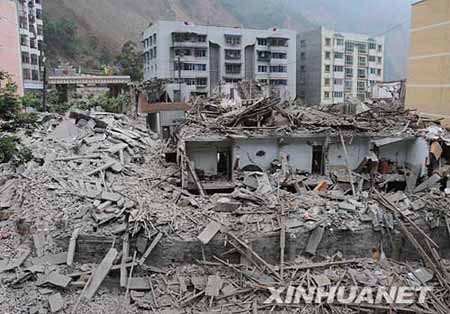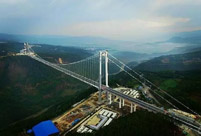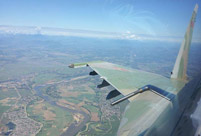


The file photo shows the scene of 2008 earthquake in Wenchuan, southwest China's Sichuan Province. [Photo: Xinhua]
Today marks the 8th anniversary of the massive Wenchuan earthquake in Sichuan which claimed around 90-thousand lives.
Since then, authorities have set up the world's most active early-warning earthquake network in the provincial capital, Chengdu, to try to prevent the massive loss of life from happening again.
The fast warning system is not meant to forecast a catastrophe.
Instead, it becomes active after an earthquake breaks at its epicenter.
Through it, its hoped cities some distance away can still be alerted before the destructive seismic waves arrive.
Designers of the network say the early-warning of anywhere from 5 to 12-seconds might be enough time for people to take shelter ahead of the impending shaking.
Chen Hong, director of the Institute of Crustal Dynamics, says the system is designed mainly to help those who might be a significant distance away from where the quake strikes.
"The best example of this technology is the system in Japan. Most of the major earthquakes which hit that country originate at sea. But, of course, its the people on land who are affected. But if the quake hits, say 100-kilometers off-shore, there is still time for the network to be effective."
Two-years ago saw the final installation of some 5-thousand monitoring stations throughout the province of Sichuan.
It covers aproximately 2-million square kilometers, and has links to the northwest in Gansu's captial, Lanzhou, as well as south in Yunnan's provincial capital, Kunming.
Through its design, people in the area can download an app to their smartphone to recieve real-time warnings.
Schools and residental areas also have the ability to link-in to the network through a terminal to provide automatic warnings when a quake has struck.
When the massive quake hit Wenchuan County in Sichuan in 2008, it hit at around 2:30 in the afternoon when children were in the midst of their afternoon classes.
It was later determined many of the schools in the quake-zone weren't built to withstand a significant earthquake.
This revelation has led to seismic reinforcement being put into all new buildings.
When Sichuan was rattled by another quake centered near the northern city of Ya'an in 2013, all of the buildings constructed after Wenchuan 5-years earlier managed to withstand the shaking.
But beyond the warnings and building reinforcement, Chinese officials are also thinking beyond the immediate disaster.
This includes the idea of catastrophic risk protection, which includes the creation of a pool of available money to cope with the aftermath of a disaster.
Chen Hong with the Institute of Crustal Dynamics says its an idea which is already being adopted in Japan and the United States.
"Catastrophic risk protection still isn't an option being provided by the insurance industry in China. But we are currently studying and borrowing the experiences of Japan and the US, where the losses in disasters can be shouldered by the government and rest of society."
Its estimated the 2008 Wenchuan earthquake did around 130-billion US dollars worth of damage.
Much of the rebuilding in Sichuan has been financed through taxpayer-funded infrastructure grants, as well as low-interest loans, put out at the start of the global financial crisis in early 2009.
 Beijing Style: ready for bare legs
Beijing Style: ready for bare legs Century-old station sees railyway evolution
Century-old station sees railyway evolution Amazing scenery of Xisha Islands
Amazing scenery of Xisha Islands Enthusiasts perform Kung Fu at Wudang Mountain
Enthusiasts perform Kung Fu at Wudang Mountain Stunning photos of China's fighter jets in drill
Stunning photos of China's fighter jets in drill Monk's mummified body to be made into a gold Buddha statue
Monk's mummified body to be made into a gold Buddha statue Asia's longest and highest suspension bridge to open to traffic
Asia's longest and highest suspension bridge to open to traffic China's first interactive robot looks like a beauty
China's first interactive robot looks like a beauty Vietnamese Su-30 fighters fly over Nanwei Island in South China Sea
Vietnamese Su-30 fighters fly over Nanwei Island in South China Sea Top 20 hottest women in the world in 2014
Top 20 hottest women in the world in 2014 Top 10 hardest languages to learn
Top 10 hardest languages to learn 10 Chinese female stars with most beautiful faces
10 Chinese female stars with most beautiful faces China’s Top 10 Unique Bridges, Highways and Roads
China’s Top 10 Unique Bridges, Highways and Roads Caution urged in overseas M&A deals
Caution urged in overseas M&A deals Activist’s cyber hunt violates moral codes
Activist’s cyber hunt violates moral codes China's radical leftists call for vocal critics of the Party to be jailed for treason
China's radical leftists call for vocal critics of the Party to be jailed for treason Step aside Twiggy – more and more Chinese people are embracing a healthy body image
Step aside Twiggy – more and more Chinese people are embracing a healthy body imageDay|Week